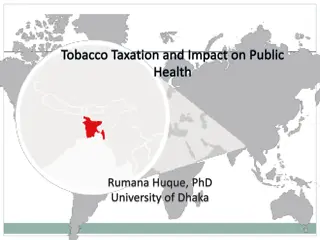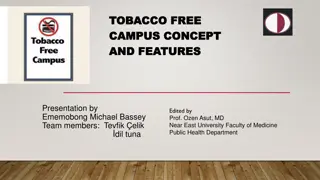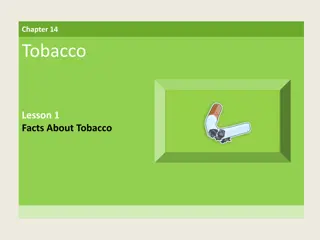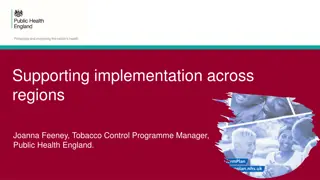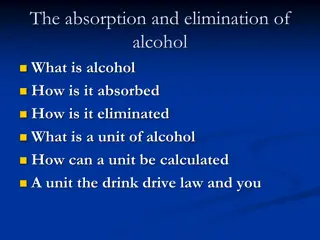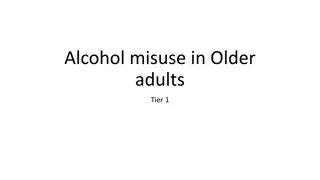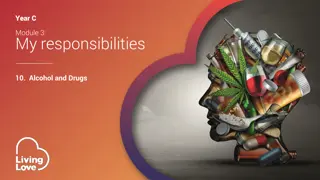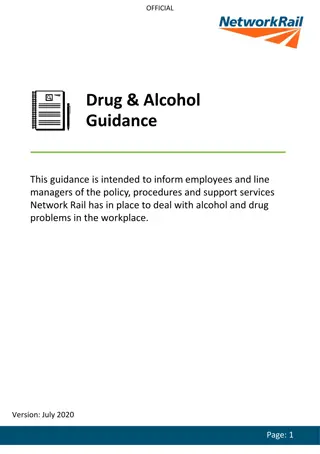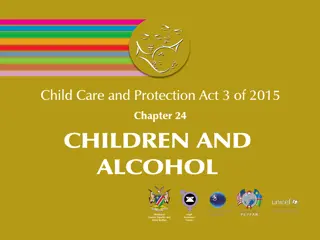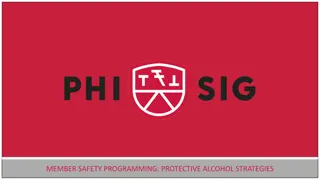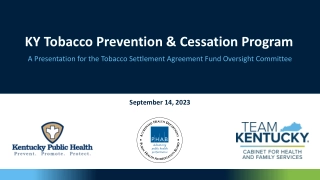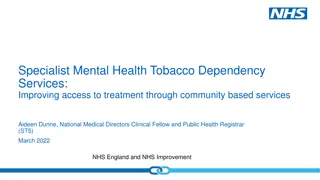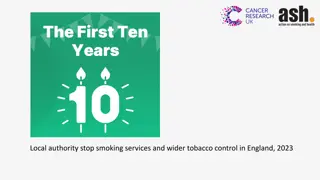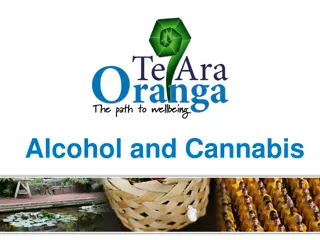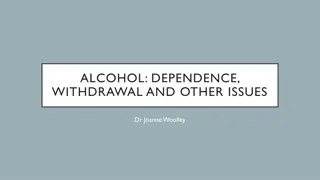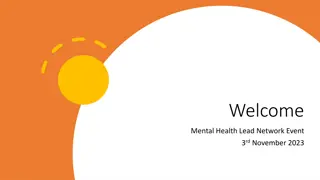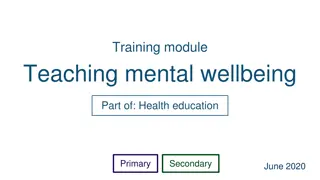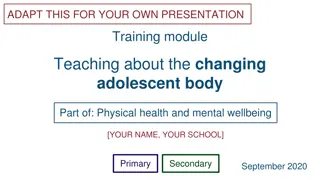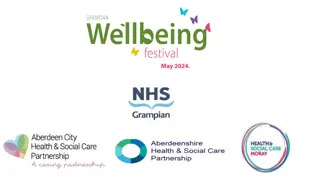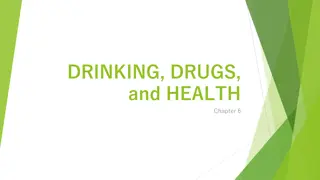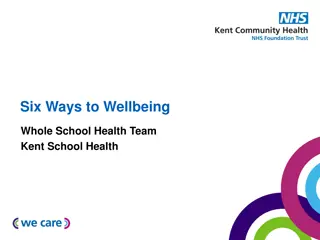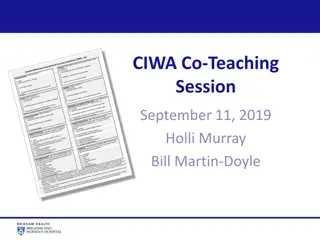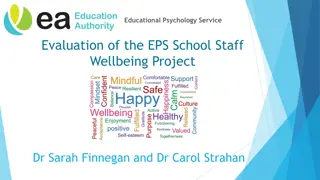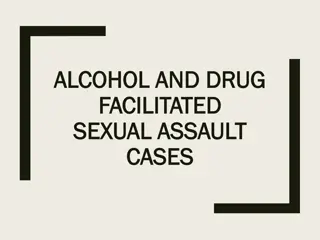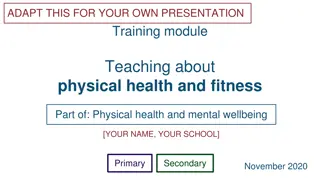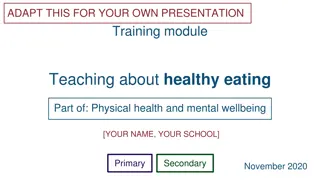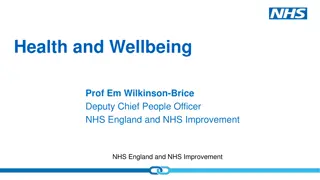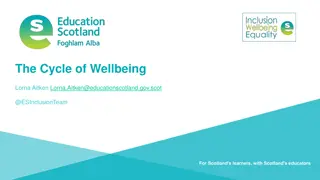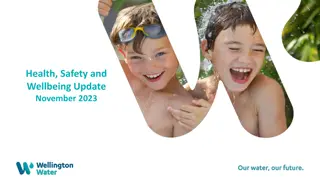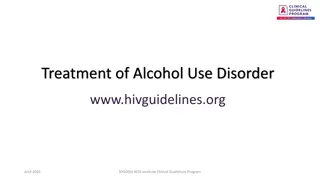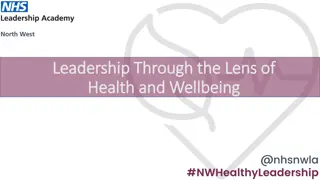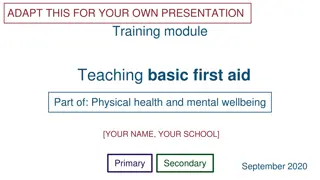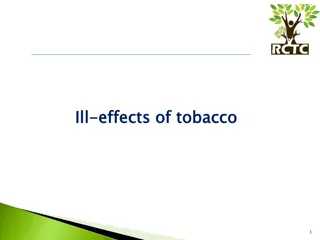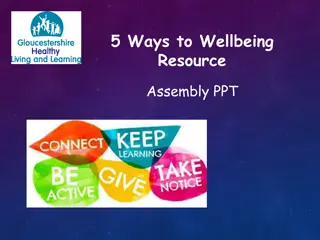Teaching about Drugs, Alcohol, and Tobacco for Physical and Mental Wellbeing
In this training module for primary and secondary schools, educators will learn how to teach about drugs, alcohol, and tobacco as part of promoting physical health and mental wellbeing. The module covers statutory guidance, key knowledge and facts, strategies for handling questions, and fostering confidence in teaching these topics effectively. It emphasizes enabling students to make well-informed decisions and understand the risks associated with substance use.
Download Presentation

Please find below an Image/Link to download the presentation.
The content on the website is provided AS IS for your information and personal use only. It may not be sold, licensed, or shared on other websites without obtaining consent from the author. Download presentation by click this link. If you encounter any issues during the download, it is possible that the publisher has removed the file from their server.
E N D
Presentation Transcript
ADAPT THIS FOR YOUR OWN PRESENTATION Training module Teaching about drugs, alcohol and tobacco Part of: Physical health and mental wellbeing [YOUR NAME, YOUR SCHOOL] Primary Secondary September 2020
Contents 3 About this training module 5 Teaching the new curriculum 14 Safeguarding 16 Ground rules 19 Primary curriculum 35 Secondary curriculum 69 Examples of good practice 75 Activities and templates for trainers 2
About this training module Subject leads can use the adaptable slides and activities and templates for trainers section at the end of this module to help shape training sessions for teachers. This non-statutory training module supplements the statutory guidance on teaching drugs, alcohol and tobacco, which schools should read in full. Schools can choose whether and how to follow or adapt this training module and should refer to the Early Career Framework for pedagogical guidance. 3
What you get out of today By the end of this training you should: know what is included in the statutory guidance know some key knowledge and facts to cover as part of this topic have strategies to deal with questions that come up in class feel more confident teaching about drugs, alcohol and tobacco 4
Making well-informed, positive choices From September 2020 schools must have regard to the new statutory guidance for teaching about drugs, alcohol and tobacco. The topic is part of the wider health education curriculum and seeks to enable pupils to make well-informed decisions through a knowledge-based approach. STATUTORY GUIDANCE It is important that the starting point for health and wellbeing education should be a focus on enabling pupils to make well-informed, positive choices for themselves. (p35) 6
Knowledge of risks and harms The drugs, alcohol and tobacco topic is part of health and mental wellbeing curriculum. It gives pupils factual knowledge about the risks posed by alcohol, drugs and tobacco use, so they are well equipped to make informed and safe choices. Teachers may also want to teach pupils about the factors that can contribute to someone drinking alcohol in excess, smoking, or using illegal drugs. This could involve teaching about social / peer pressure. The following related modules contain more information on these issues: respectful relationships being safe 7
Related topics Drugs, alcohol and tobacco is related to the science curriculum as well as topics such as: health and prevention physical health and fitness healthy eating basic first aid Therefore you should: consider thematic links across key topics and the whole school when planning and delivering lessons find ways to link knowledge and vocabulary across topics 8
Support with this topic at [school name] Our leads [Names, contact details of safeguarding leads] Our policies [Add details - e.g. school policy on drugs] Specialist support [Add details - e.g. providers school already works with] Other information [Add resources] 9
Drugs, alcohol and tobacco teaching at [school name] Ways in which we already teach about the risks of drugs, alcohol and tobacco at our school: [add details] [add details] [add details] 10
Primary and secondary teaching Some slides in this training have a Primary or Secondary label to indicate that the material is usually first introduced in that phase. STATUTORY GUIDANCE Schools have flexibility to design and plan age-appropriate subject content. (p31) Using your knowledge of your pupils and school community you can: introduce secondary content in primary with pupils who need it and are ready teach the primary content in early secondary lessons to pupils who need to build knowledge before secondary content is taught 11
Pupils with SEND You will need to plan lessons to allow all pupils to access and practise the core knowledge, using your expertise as you normally would. You might want to link lesson outcomes with statutory preparing for adulthood outcomes for those with an education, health and care (EHC) plan. (See SEND code of practice, section 8.) STATUTORY GUIDANCE In special schools and for some SEND pupils in mainstream schools there may be a need to tailor content and teaching to meet the specific needs of pupils at different developmental stages. As with all teaching for these subjects, schools should ensure that their teaching is sensitive, age-appropriate, developmentally appropriate and delivered with reference to the law. (p15) 12
Teacher wellbeing The new curriculum covers a wide range of topics, some of which individual teachers might find personally challenging in different ways. It is important to feel you can ask for support or raise questions if: you have personal experience of a topic which makes teaching that content particularly challenging for you you have personal views on a topic that mean you need to discuss how you can ensure the teaching is delivered objectively Talk to your line manager, in the first instance, if you do need support. 13
Safeguarding 14
Safeguarding (1) Pupils may be affected by issues discussed in lessons. Let your designated safeguarding lead or deputy and any other relevant staff, such as pastoral leads, know what you are teaching. This will enable them to identify and speak to relevant pupils, especially those who they know may have been directly impacted by issues covered in the lessons and those with adverse childhood experiences. Teachers may need to deal with disclosures or concerns (e.g. of abuse or offending behaviour) in a way that safeguards pupils in line with school policies, especially the child protection policy. 15
Ground rules 16
Create class ground rules Clear class ground rules can help when teaching about sensitive topics. They also support confidentiality and safeguarding of pupils. Good practice is for ground rules to be: discussed and understood by all clear and practical modelled by the teacher followed consistently and enforced updated when needed visible in lessons (for example, posters) 17
Example ground rules Respect privacy. We can discuss examples but do not use names or descriptions that identify anyone, including ourselves. Listen to others. It is okay to disagree with each other, but we should listen properly before making assumptions or deciding how to respond. When disagreeing, challenge the statement not the person. No judgement. We can explore beliefs and misunderstandings about a topic without fear of being judged. Choose level of participation. Everyone has the right to choose not to answer a question or join discussion. We never put anyone on the spot (no personal questions or pressure to answer). 18
Legal and illegal harmful substances STATUTORY GUIDANCE Know the facts about legal and illegal harmful substances and associated risks, including smoking, alcohol use and drug- taking. Give a clear definition of drugs (substances that change the way the body or mind works). Teach pupils that there are different types of drugs: medicines (prescribed by a doctor and over the counter , e.g. paracetamol) legal drugs that are not medicines (e.g. alcohol, tobacco and caffeine) illegal drugs (give examples if appropriate) other substances that are misused as drugs Primary 20
Tobacco 21
Smoking basics STATUTORY GUIDANCE Know the facts about legal and illegal harmful substances and associated risks, including smoking, alcohol use and drug- taking. Explain that smoking is inhaling the smoke from burning tobacco (which is made out of the dried leaves of the tobacco plant). When tobacco is burned it releases dangerous substances including: tar - a toxic substance that damages lungs over time carbon monoxide - a toxic gas that is absorbed through the lungs and enters the bloodstream Tobacco also contains a highly addictive chemical called nicotine which makes it hard to stop smoking. Teach pupils about harms of smoking and the strong link between smoking and serious health conditions (NHS). Primary 22
Smoking risks and dangers STATUTORY GUIDANCE Know the facts about legal and illegal harmful substances and associated risks, including smoking, alcohol use and drug- taking. Explain that smoking is one of the biggest causes of death and illness in the UK. For example, it can: cause cancer in various parts of the body (including lungs, mouth, bowel and liver) damage your lungs, leading to lung diseases that make breathing difficult increase the risk of a heart attack and stroke make asthma and the common cold worse Bear in mind that these facts may scare pupils who have parents who smoke. Primary 23
Passive smoking STATUTORY GUIDANCE Know the facts about legal and illegal harmful substances and associated risks, including smoking, alcohol use and drug- taking. Teach pupils that all of the risks for smoking can also occur as a result of passive smoking . This is when people accidentally breathe in other people s smoke. Babies and children are particularly vulnerable to the effects of second-hand smoke. Explain that due to the risks of passive smoking, it is against the law to smoke in workplaces, enclosed public buildings and on public transport. Explain that it is also illegal to smoke in an enclosed private vehicle if someone under 18 is also present. Read more about passive smoking on NHS.UK. Primary 24
E-cigarettes (vaping) STATUTORY GUIDANCE Know the facts about legal and illegal harmful substances and associated risks, including smoking, alcohol use and drug- taking. Teach pupils that e-cigarettes allow someone to inhale nicotine in a vapour instead of through tobacco smoke. People sometimes use e-cigarettes when they are trying to give up smoking. However, vaping also carries risks, and no-one should start vaping unless they are trying to give up smoking, because: e-cigarette liquid/vapour still contains low levels of potentially harmful chemicals the long-term health risks of vaping (e.g. to heart, lungs and blood vessels) are not known most e-cigarettes contain addictive nicotine Primary 25
Alcohol 26
Alcohol use (1) STATUTORY GUIDANCE Know the facts about legal and illegal harmful substances and associated risks, including smoking, alcohol use and drug- taking. Teach that alcohol is a clear liquid drug (chemical name - ethanol). It is found in different amounts in alcoholic drinks such as beer, wine and spirits. Acknowledge that many adults drink alcohol, e.g. in social situations. Explain that many people also choose not to drink any alcohol, introducing vocabulary such as teetotal . Teachers may also refer to faith perspectives, e.g. that some religions prohibit / strongly discourage drinking alcohol. Primary 27
Alcohol use (2) STATUTORY GUIDANCE Know the facts about legal and illegal harmful substances and associated risks, including smoking, alcohol use and drug- taking. Begin to introduce pupils to the risks of alcohol to physical and mental health (e.g. cancers, stroke, heart disease, liver disease, alcohol poisoning). Explain that when adults drink more than a certain amount (NHS guidelines) the risks increase. Teach that alcohol can be addictive and that it can be hard for people to give up or cut back their drinking if they are addicted. Teachers can also refer to content on alcohol use in the secondary slides in this module, if they think they are appropriate. Primary 28
Smoking/alcohol age restrictions STATUTORY GUIDANCE Know the facts about legal and illegal harmful substances and associated risks, including smoking, alcohol use and drug- taking. Teach pupils that some legal drugs have age restrictions to protect young people. Smoking: Ensure pupils understand laws about children buying cigarettes. You must be 18 or older to buy cigarettes in the UK. It is illegal to sell tobacco, electronic cigarettes (e-cigarettes) or e-liquids to anyone under 18, or to buy them for anyone under 18. Alcohol: It is illegal to buy or try to buy alcohol if you are under 18. It is also illegal to sell alcohol to, or buy alcohol for, under 18s. Ensure pupils understand laws relating to alcohol and young people. Primary 29
Drugs 30
Illegal drugs risks STATUTORY GUIDANCE Know the facts about legal and illegal harmful substances and associated risks, including smoking, alcohol use and drug- taking. Teach that it is highly dangerous to take illegal drugs because they can cause serious harm to physical and mental health, and even death. The effects of some illegal drugs can be very fast. Teach that people are also committing a crime if they possess, buy or sell illegal drugs. Explain that some illegal drugs can also be highly addictive. Primary 31
Prescription drugs risks STATUTORY GUIDANCE Know the facts about legal and illegal harmful substances and associated risks, including smoking, alcohol use and drug- taking. Teach that legal drugs / medicines can cause serious harm to people s health and wellbeing if misused. This includes both prescribed and over the counter medicines such as paracetamol. Explain that people should only take medicines that a doctor or parent tells them to take, following any extra instructions. It is very dangerous to take other people s prescription drugs, which could make us unwell. Explain that some legal drugs can also be highly addictive if misused. Primary 32
Addiction risk STATUTORY GUIDANCE Know the facts about legal and illegal harmful substances and associated risks, including smoking, alcohol use and drug- taking. Teach pupils that smoking, drinking alcohol and taking certain types of drugs can be addictive (varies by substance and frequency of use) and what this means. Explain that: it can be hard for people to stop using a substance once they are addicted addictions sometimes lead to problems such as abusive behaviour and debt there is help available for people who want to stop smoking, drinking alcohol or taking drugs Teacher reference: Addiction: What is it? (NHS) Primary 33
Risks of accidents after drinking or using drugs STATUTORY GUIDANCE Know the facts about legal and illegal harmful substances and associated risks, including smoking, alcohol use and drug- taking. Explain that some substances (including alcohol and both illegal and some legal drugs) can affect how people s brains and bodies work, often slowing down thinking and responses. This makes activities such as using machinery, driving or swimming particularly dangerous. The risk of serious accidents from these and other activities are much higher after people have consumed alcohol or drugs. Primary 34
Secondary curriculum STATUTORY GUIDANCE Schools should continue to develop knowledge on topics specified for primary as required and in addition cover the following content by the end of secondary. (p36) 35
Drugs (1) 36
About drugs STATUTORY GUIDANCE Know the facts about legal and illegal drugs and their associated risks, including the link between drug use, and the associated risks, including the link to serious mental health conditions. Building on knowledge from primary, teach pupils that drugs are defined as a medicine or other substance which has a physiological effect when ingested or otherwise introduced into the body. This means that a drug is something that changes how the body functions and feels. Teach pupils that there are different types of drugs: medicines (prescribed and over the counter ) legal drugs that are not medicines (e.g. alcohol, tobacco, caffeine) illegal drugs substances that are misused as drugs Secondary 37
Illegal drugs STATUTORY GUIDANCE Know the facts about legal and illegal drugs and their associated risks, including the link between drug use, and the associated risks, including the link to serious mental health conditions. Teach pupils that there are different types of illegal drug (e.g. stimulants, depressants and hallucinogens). Make pupils aware of some common illegal drugs, such as cocaine, ecstasy, heroin and cannabis. Teachers may consider pupils context, including prevalence of certain drugs in the wider community, when planning the content of lessons. Great care must be taken not to make any illegal drug sound attractive when discussing its impact. Teacher reference: Frank A-Z of drugs. Secondary 38
Substance misuse STATUTORY GUIDANCE Know the facts about legal and illegal drugs and their associated risks, including the link between drug use, and the associated risks, including the link to serious mental health conditions. Teach pupils that there are some legal substances that people sometimes misuse as drugs. Explain that any substance used for purposes other than those intended can be dangerous and could even cause death. Secondary 39
Health risks of illegal drugs STATUTORY GUIDANCE Know the facts about legal and illegal drugs and their associated risks, including the link between drug use, and the associated risks, including the link to serious mental health conditions. Explain that illegal drugs are highly dangerous and: contain uncontrolled quantities of dangerous chemicals have serious short- and long-term health risks carry a risk of death the first and every subsequent time they are used can be highly addictive Warn pupils that people are at even higher risk if: they mix different types of drugs, or take both illegal drugs and alcohol (also a drug) they already have physical/mental health problems Secondary 40
Drug risks awareness STATUTORY GUIDANCE Know the facts about legal and illegal drugs and their associated risks, including the link between drug use, and the associated risks, including the link to serious mental health conditions. Increase pupils awareness of illegal drugs and their risks by referring to relevant examples in classes. Explain: what the drug is (including common names) short-term physical and mental health risks long-term physical and mental health risks how addictive it is the law (e.g. class of drug and penalties) Remind pupils that illegal drugs could contain any substance, in any quantity. This makes them even more dangerously unpredictable. Secondary Teacher reference: Frank A-Z of drugs. 41
Illegal drugs and mental health STATUTORY GUIDANCE Know the facts about legal and illegal drugs and their associated risks, including the link between drug use, and the associated risks, including the link to serious mental health conditions. Teach that illegal drug use can lead to complex mental health problems. Drug-taking (even single/occasional use) can cause or contribute to: anxiety and depression hallucinations, paranoia, memory loss Teacher reference: The effects of drugs (NHS). Secondary 42
Dangers of self-medication STATUTORY GUIDANCE Know the facts about legal and illegal drugs and their associated risks, including the link between drug use, and the associated risks, including the link to serious mental health conditions. Teach that people sometimes inappropriately use substances to try to cope with symptoms of pre-existing health problems such as physical pain, sleeplessness or anxiety. Explain that this can be dangerous to health and could lead to addiction. If someone has a medical problem they should always seek advice and treatment from a doctor. Secondary 43
Illegal drugs and the law STATUTORY GUIDANCE Know the law relating to the supply and possession of illegal substances. Teach that in the UK there are laws relating to possessing, supplying, carrying and making illegal drugs. The punishment can vary depending on the amount and type of drug (e.g. its class ). Explain that the age of criminal responsibility is 10 years old. This means that people aged 10 to 17 can be cautioned, tried for criminal offences and gain a criminal record. Teacher reference: Drugs penalties, Age of criminal responsibility (GOV.UK). Secondary 44
Travel abroad and drugs STATUTORY GUIDANCE Know the law relating to the supply and possession of illegal substances. Teach pupils that other countries have different laws and punishments for drug offences (e.g. drug trafficking). Add that if a person commits a crime in another country they are subject to that country s legal system. Taking any illegal drug into another country is highly dangerous and can result in tough punishments in that country (some examples can be explored). People taking a prescription drug abroad should always take a prescription to prove it is theirs. They should check NHS advice on taking medicines abroad and check the rules for the country they are visiting. Secondary 45
Impact of drug convictions STATUTORY GUIDANCE Know the law relating to the supply and possession of illegal substances. Explain to pupils that drug charges and convictions (a criminal record) can have a long-term impact on their life choices. They can: make it harder to get a job limit the ability to travel to many countries, such as the US Many illegal drugs are also very expensive and addictive. This combination can lead people to commit other crimes to pay for drugs. Secondary 46
Wider impact of illegal drugs STATUTORY GUIDANCE Know the facts about legal and illegal drugs and their associated risks, including the link between drug use, and the associated risks, including the link to serious mental health conditions. Teach pupils that buying and using illegal drugs has a social impact . When people buy drugs they contribute towards demand (e.g. drug trafficking), which encourages more criminal activity (e.g. intimidation and recruitment of young people into illegal gangs). Secondary 47
Prescription drugs risks (1) STATUTORY GUIDANCE Have an awareness of the dangers of drugs which are prescribed but still present serious health risks. Teach pupils the dangers associated with incorrect use of prescription (and over the counter ) drugs such as painkillers, antidepressants and steroids. People should only take drugs prescribed to them personally by their doctor (and at the dose specified). They should tell their doctor if they: experience side effects feel their condition has worsened take too much (and instructions say to tell doctor) Explain that it is often unsafe to mix prescription drugs with other medicines or alcohol. Secondary 48
Prescription drugs risks (2) STATUTORY GUIDANCE Have an awareness of the dangers of drugs which are prescribed but still present serious health risks. Teach pupils that people should never: take drugs that have been prescribed for someone else share their medicines with someone else If someone takes medicine that has not been prescribed to them they could get very ill or have a dangerous reaction. Also teach that there are risks in buying prescription drugs online (NHS) - e.g. self diagnosis, wrong dose, not the drug you think you are buying. Secondary 49
Drugs, crime and illegal gangs (1) STATUTORY GUIDANCE Know the facts about legal and illegal drugs and their associated risks, including the link between drug use, and the associated risks, including the link to serious mental health conditions. Teach pupils there is a link between drugs and crime, including illegal gangs (e.g. county lines gangs). Such gangs often use people (including very young children) to move and store drugs and money for them. Gangs manipulate and pressure people to become more involved in different ways, for example by: offering money, presents such as mobile phones, false friendship , addictive drugs using threats, violence and abuse getting people to do bad/illegal things so they do not feel able to ask for help (e.g. from family, the police) Secondary 50


